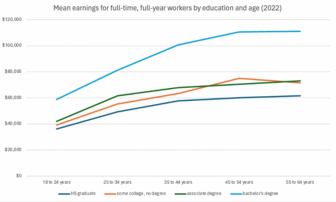
A little more than a year ago the Grand Rapids Public Museum hosted Outsmarting the Robots: Redesigning education from the classroom to the halls of Lansing. The conference was organized around the question “how do we redesign our system for learning to build the 21st century skills that matter to meeting the needs of our children, economy, society, and world?”
The conference organizers––including Michigan Future––believed that our education system needed redesign of both what we are teaching and how we are teaching. That standardized test driven schooling––now delivered both in schools and at home––is designed to teach a too narrow set of skills and is delivered in a way that does not engage students nor create lifelong learners.
New York Times best-selling author of Becoming Brilliant, Kathy Hirsh-Pasek served as the conference guide.
Becoming Brilliant makes the case that the foundation skills for all students––no matter what path they choose to take after high school––are the 6Cs: communication, collaboration, content, critical thinking, creativity and confidence. These, of course, are essential life skills. They also are the skills students will need to outsmart the robots. To complement rather than be replaced by machines and to compete in a labor market that is increasingly rewarding those who are good at working with, solving problems with, innovating with and leading people who don’t look like you and don’t think like you.
Becoming Brilliant describes what we should be teaching. In a new report for Brookings entitled A new path to education reform: Playful learning promotes 21st century skills in schools and beyond, Hirsh-Pasek and her co-authors describe how to teach those skills. They detail six key characteristics that are inherent in playful learning contexts:
- Active (Minds on): Where children are focused and engaged in the learning process through questioning and reflection—over passive learning where students listen and memorize information.
- Engagement: Learning environments for children to filter out distractions and focus their attention on the task at hand.
- Meaningful: Where children can connect their own experiences and interests to new information.
- Socially interactive: Beginning in infancy, we seek out interactions with others. This desire for social interaction is fundamental to education.
- Iterative: An ever-growing body of literature demonstrates that children generate, test, and revise hypotheses while interacting with their environment based on data.
- Joyful: Emotion and imagination go hand in hand, and are integral to the development of creativity
The authors conclude:
This approach fundamentally alters the traditional view of educational success of “Did our child do well on the test?” to a definition that celebrates happy, healthy, thinking, caring, and social children who become collaborative, creative, competent, and responsible citizens tomorrow.
This is a very different redesign of teaching and learning than the one we most often hear about: self-paced learning on a computer. As our former colleague Patrick Cooney wrote in a blog entitled A 21st century education, technology not required:
It is clear that students don’t need computers to engage in any of the 6Cs listed above, and if used incorrectly they can be counterproductive. We’ve seen schools where personalized learning platforms simply take the mindless, skill-building exercises students would normally do in a textbook and transfer them to a computer screen. And we’ve seen kids plopped in front of a computer to progress through material at their own pace, only they lack both the requisite skills needed to access the material, and the motivation to engage in the work in the first place.
This isn’t a 21st century education. No matter how sophisticated the platform, if digital tools lead to students spending a large portion of their day working alone on a narrow-band of skills, rather than building deep understanding, working collaboratively with classmates on meaningful projects, and being asked to think critically about the information they’re presented, then computers can in fact hinder the development of the 6Cs.
The how to lesson we need to learn is that you build 6Cs foundation skills in all our children through the active, engaging, interactive teaching and learning––both in school and at home––that Hirsh-Pasek describes.
Another important lesson to learn is that the same what and how applies to extracurriculars as well as after school, youth development and summer programs. Sports, the arts, robotics, or science may be the theme of these programs, but the essential skills these programs can and should be designed to build are the 6Cs.
The “21st century skills in schools and beyond” in the title of the new Brookings report is exactly right. Extracurriculars, after school, youth development and summer programs are already designed around active, engaging, interactive learning. They should be considered essential components of our teaching and learning system and be widely available to all children.







